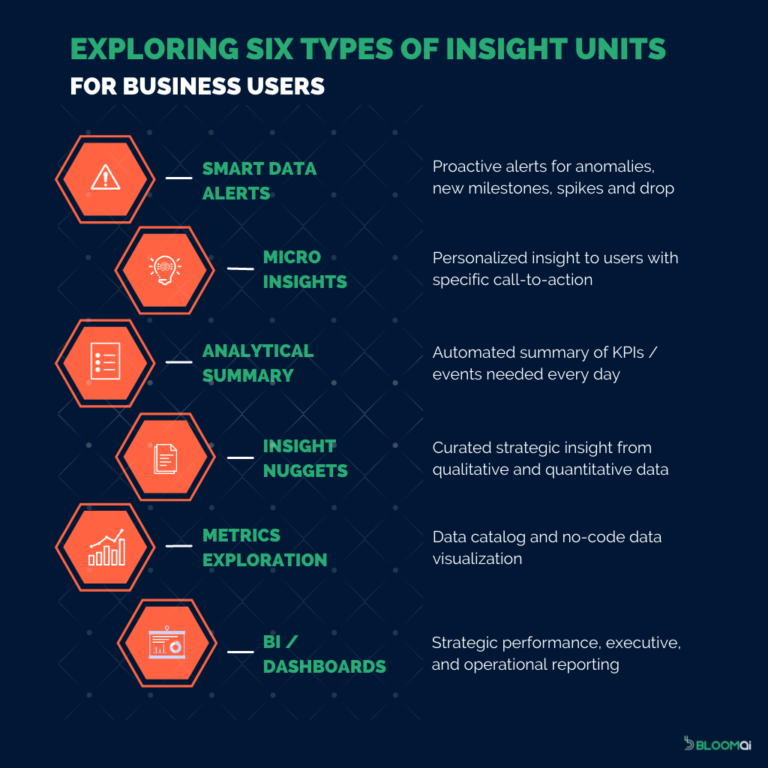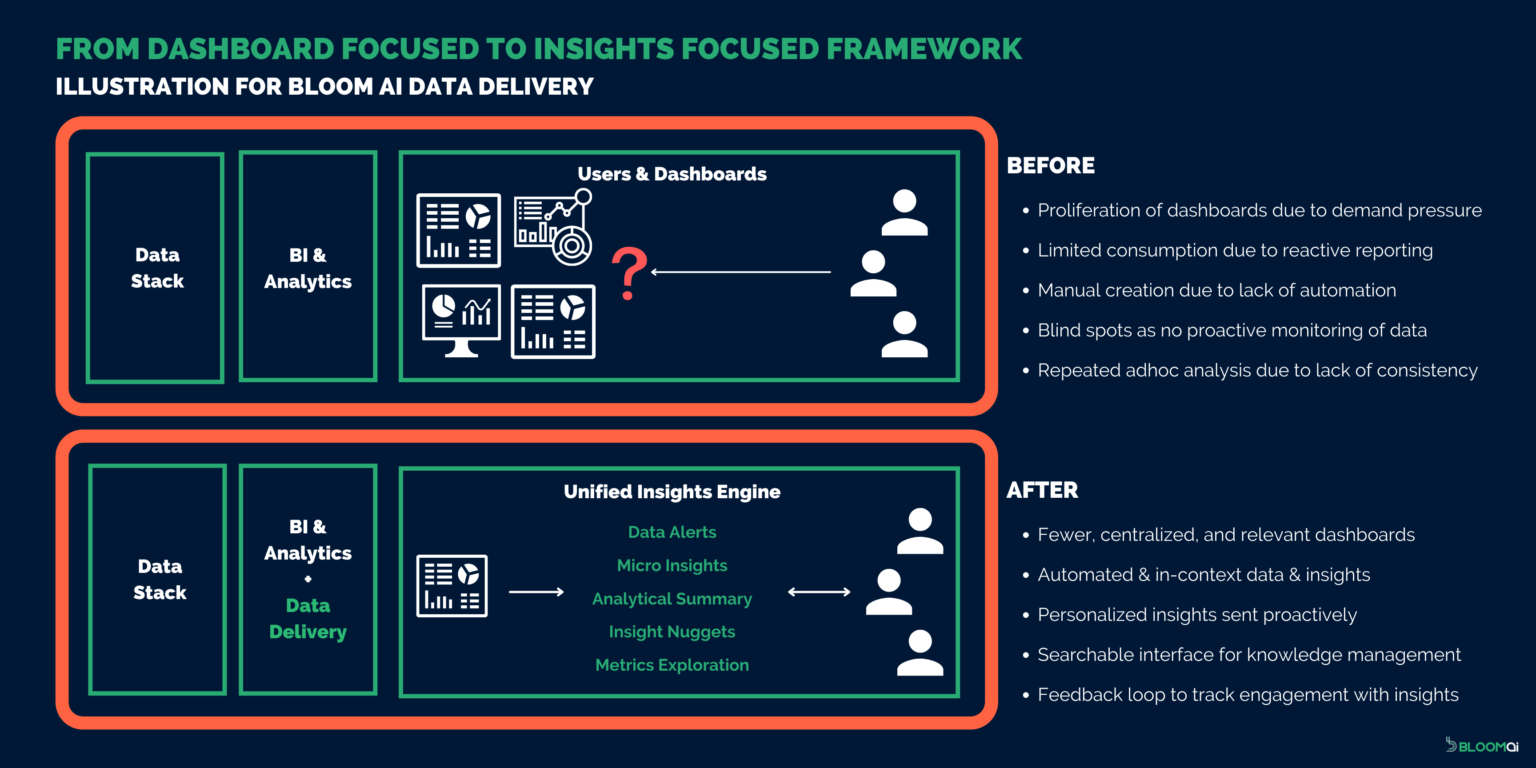Moving from “data utility” to “data-driven” status
The race to become a data-driven enterprise is progressing at break-neck speed. Data and technology investments helped enterprises achieve a “data utility” status with charts, dashboards, and reports available across users. But, instead of being guided by newfound insights from these data utilities, users have become “data-dazed” as they encounter slow, complex, and fragmented insights.
Innovation in cloud, AI & automation is starting to solve issues in data management. But the last mile (user solutions) continues to be some version of dashboards limiting the enterprise to achieve its “data-driven” status.
Thirsty in an ocean full of water
The image of sailors going thirsty after depleting their freshwater sources while surrounded by an ocean has always left a sense of frustration. If only they could have found a way to desalinate the ocean water.
Enterprises are finding themselves in the same situation. Imagine a sales & marketing department of a Fortune 500 company with fifty (50) dashboards. Despite being surrounded by volumes of information; they do not have a way to distill critical insights. Business users need targeted insights that answer their job-specific questions instead of exhaustive sets of KPIs, filters, and charts. For instance, B2B salespeople need answers to the following questions:
- How is my sales team’s performance this week?
- Have we identified any noticeable activity that requires attention?
- Is there any overperforming content that we should be sharing with customers?
- Which segment of my clients is unhappy?
The answers to these questions are either hidden away in a global sales dashboard or are slow to generate. Even more challenging, the data and analytic teams’ lack of communication with the sales team prevents them from developing relevant dashboards capable of delivering impactful and timely insights.
Users are looking for simple, proactive, and personalized monitoring to focus on execution rather than gathering and processing. With less than 10% of dashboards actively used today, enterprises are still making the mistake of thinking more dashboards and tools will generate more insights. This is all leading to significant missed opportunities.
The Gartner sales workflow below shows how the current movement from KPIs and Questions to action is slow and linear. Transitioning to an augmented analytics workflow, enterprises can execute on insights at any point of the journey.

The shoe fits…Until it doesn’t
Dashboards have been the default choice for sharing analysis and insights. In a recent discovery exercise with a client, we identified that 70% of the existing use cases did not fit into a dashboard requirement. Instead, the client wanted to use prioritized alerts based on descriptive data or predictive models for alerting immediate action to users instead of insight sharing.
For instance, while tracking Salesforce customer interactions, customer success managers need specific call-to-action insights for:
- Negative sentiment in clients for a particular feature/service
- Cases that required immediate resolution
- Reduced engagement within a particular segment of clients
- Raise pricing concerns with a client
Simply creating dashboards for the actions above can delay a customer success manager’s ability to act on essential insights. This could even negatively impact their revenue, compliance, or client relationship. On the other hand, creating targeted insights or alerts for relevant stakeholders in real-time will enhance client value and experience.
tl;dr: Your team is missing key insights
“Too long, didn’t read” has turned into a common phenomenon where stakeholders do not read lengthy documents, presentations, and in some cases, long emails. Executives and users alike want to “get to the point” faster. To foster this rising attitude, executives such as Elon Musk and Jeff Bezos have banned PPTs during presentations.
Similar to tl;dr, “too complex, didn’t read” and “too slow, didn’t read” situations have also been popping up as reasons for not finding key insights. Executives and business teams want short summaries and simple, digestible insights that can help them win clients.
Data and business teams spend a considerable chunk of their time preparing extensive reports. Still, users are looking for time-sensitive, event-based, or continuous data-based insights. Making insights simple and digestible can equip the team with the key insights they need daily. A leading tech company, for example, has started sharing strategic insights via newsletters with their front-line teams, so they know the three most valuable insights around competitors, products, or markets.
“Key takeaway: Data Visualization alone is not Data Delivery“
Finding the missing link in Data Delivery
Organizations will have to consider transitioning to an insights-based framework rather than solely visualization-based dashboards to create impact with data. The complexity and magnitude of data enterprises require the augmentation of current dashboard solutions to provide real-time value urgently.
We believe Data delivery is the missing link in the data stack that enables proactive, contextual, and personalized data & insights to businesses at scale and speed. This layer allows for data-driven decision making through:
- Advanced performance monitoring that augments existing reporting frameworks
- Ability to act on generated information instead of insight gathering and processing
- Highlighting blind spots, strategic insights, or missed opportunities
The Bloom AI Data Delivery Platform for Data-Driven Business
At Bloom AI, we see the future of enterprise information as an assembly of “insight units” for business teams based on context, role, and call to action. As seen below, each of these insight units will collectively create the Data Delivery Platform.

Built on an insights-as-a-service architecture, the Bloom AI platform provides the ability to automate, contextualize, and prioritize the most valuable insights that help data & business teams:
Focus:
Users have access to real-time, relevant insights that they need every day
Integrate:
Sits on top of the existing data stack and scales with the user requirements
Improve:
Feedback loop and CTAs enable consumption & actionability tracking

About Bloom AI
Bloom AI (https://bloomai.co/) is a Data Delivery Platform that reimagines how business users access and experience data for faster, more informed decisions every day. Built on an insights-as-a-service (IAAS) infrastructure, Bloom AI product & solutions focus on speed, context, and personalization of your most valuable data use cases, without overwhelming you with tools or technology.
Bloom AI’s mission is to help clients harness the full potential of data & information to drive business growth, creativity, and sustainability. Our focus is on solving the last mile data & insights delivery for business users in a cloud-first environment. Bloom AI is in Raleigh, North Carolina, and Gurugram, India.
To learn more about how we can help data delivery in your organization, please reach out to Amit Shanker at amit@bloomai.co.
